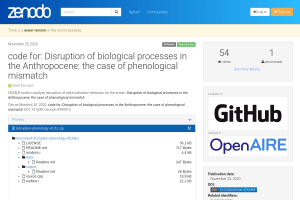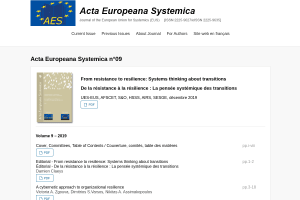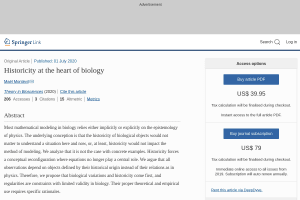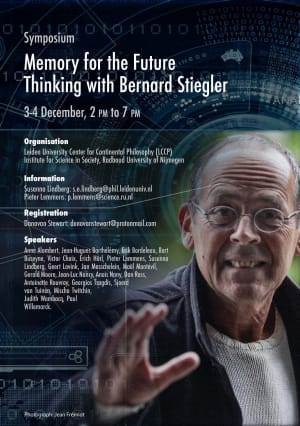
-

-
Code for: Disruption of biological processes in the Anthropocene: the case of phenological mismatch
CRAN R code to analyze disruption of plant-pollinator networks for the article: Disruption of biological processes in the Anthropocene: the case of phenological mismatch.
Abstract
CRAN R code to analyze disruption of plant-pollinator networks for the article: Disruption of biological processes in the Anthropocene: the case of phenological mismatch
Citation Publisher DetailsCitation
Montévil, Maël. 2020. “Code for: Disruption of Biological Processes in the Anthropocene: The Case of Phenological Mismatch.” Code, Github/Zenoto; Zenodo. https://doi.org/10.5281/zenodo.4290494 -

Bernard Stiegler (1952-2020)
Unpublished text written after the death of Bernard Stiegler.
-
From physics to biology by extending criticality and symmetry breakings: An update
Acta Europeana Systemica
We show that symmetries play a radically different role in biology by comparison with physics. This article is an updated version of the 2011 paper.
Abstract
Symmetries play a major role in physics, in particular since the work by E. Noether and H. Weyl in the first half of last century. Herein, we briefly review their role by recalling how symmetry changes allow to conceptually move from classical to relativistic and quantum physics. We then introduce our ongoing theoretical analysis in biology and show that symmetries play a radically different role in this discipline, when compared to those in current physics. By this comparison, we stress that symmetries must be understood in relation to conservation and stability properties, as represented in the theories. We posit that the dynamics of biological organisms, in their various levels of organization, are not “just” processes, but permanent (extended, in our terminology) critical transitions and, thus, symmetry changes. Within the limits of a relative structural stability (or interval of viability), qualitative variability is at the core of these transitions.
Keywords: Coherent structures, Critical transitions, downward causation, Hidden variables, Levels of organization, Symmetries, Systems biology
Manuscript Citation Publisher Full textCitation
Longo, Giuseppe, and Maël Montévil. 2020. “From Physics to Biology by Extending Criticality and Symmetry Breakings: An Update.” Acta Europeana Systemica 9 (1): 77–92. https://doi.org/10.14428/aes.v9i1.56043 -
Historicity at the heart of biology
Theory in Biosciences
Most mathematical modeling in biology rely on the epistemology of physics. By contrast, we argue that historicity comes first in biology.
Abstract
Most mathematical modeling in biology relies either implicitly or explicitly on the epistemology of physics. The underlying conception is that the historicity of biological objects would not matter to understand a situation here and now, or, at least, historicity would not impact the method of modeling. We analyze that it is not the case with concrete examples. Historicity forces a conceptual reconfiguration where equations no longer play a central role. We argue that all observations depend on objects defined by their historical origin instead of their relations as in physics. Therefore, we propose that biological variations and historicity come first, and regularities are constraints with limited validity in biology. Their proper theoretical and empirical use requires specific rationales.
Keywords: Historicity, Organization, Epistemology, Mathematical modeling, Constraints
Manuscript Citation Publisher Full textCitation
Montévil, Maël. 2020. “Historicity at the Heart of Biology.” Theory in Biosciences, July. https://doi.org/10.1007/s12064-020-00320-8 -

Panel: Towards anti-entropic exorganisms and exorganisations in the Anthropocene. Bioeconomics, Institutions, Localities
Why should we invest in the concept of entropy to face the challenges of the Anthropocene? Of course, entropy production is a more accurate description of physical processes than energy consumption – and the difference between the two concepts has applications. However, entropy has other ramifications. Living beings oppose entropy increase in two different ways. First, as emphasized by Schrödinger, living beings have to sustain a low entropy situation, and this implies that they are local, open systems. Second, while entropy increase leads to more generic configurations, biological individuation brings about the more specific organization, at the scale of evolution as well as shorter time scales. These specific organizations are precisely the way living being delay the increase of entropy. These counter-trends are analyzed as anti-entropy and anti-entropy production, respectively. We will show that they are damaged in the Anthropocene, meaning that biological organizations are disrupted, and their ability to reorganize is also weakened.
-
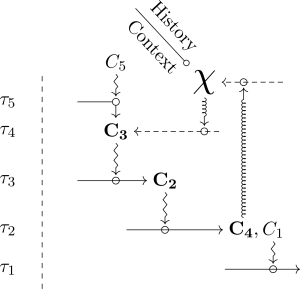
The Identity of Organisms in Scientific Practice: Integrating Historical and Relational Conceptions
Frontiers in Physiology
We address the identity of biological organisms in scientific practices by combining relational and historical conceptions, and introduce a new symbol for that.
Abstract
We address the identity of biological organisms at play in experimental and modeling practices. We first examine the central tenets of two general conceptions, and we assess their respective strengths and weaknesses. The historical conception, on the one hand, characterizes organisms’ identity by looking at their past, and specifically at their genealogical connection with a common ancestor. The relational conception, on the other hand, interprets organisms’ identity by referring to a set of distinctive relations between their parts, and between the organism and its environment. While the historical and relational conceptions are understood as opposed and conflicting, we submit that they are also fundamentally complementary. Accordingly, we put forward a hybrid conception, in which historical and relational (and more specifically, organizational) aspects of organisms’ identity sustain and justify each other. Moreover, we argue that organisms’ identity is not only hybrid but also bounded, insofar as the compliance with specific identity criteria tends to vanish as time passes, especially across generations. We spell out the core conceptual framework of this conception, and we outline an original formal representation. We contend that the hybrid and bounded conception of organisms’ identity suits the epistemological needs of biological practices, particularly with regards to the generalization and reproducibility of experimental results, and the integration of mathematical models with experiments.
Manuscript Citation Publisher Full textCitation
Montévil, Maël, and Matteo Mossio. 2020. “The Identity of Organisms in Scientific Practice: Integrating Historical and Relational Conceptions.” Frontiers in Physiology 11 (June): 611. https://doi.org/10.3389/fphys.2020.00611 -
Non-monotonicity of BPA
In their presentation, the scientists provide background on CLARITY-BPA, the setup of their mammary gland study, and a detailed discussion of the analytical and statistical methods applied. They explain that their study shows clear statistical evidence of non-monotonic dose-response curves (NMDRC) of developmental exposure to BPA for multiple measurements, that such responses occurred at all ages of the animals studied, and argue that additional “mechanistic studies are not needed to accept that a NMDRC reflects a causal link to the exposure when the statistical methods of analysis are pertinent and rigorous.”
-
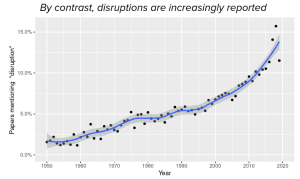
Workshop: What does it mean for chemicals to be endocrine disruptors?
Since the Wingspread conference in 1991, endocrine disruptors are an active field of research and concern for public health. This workshop aims to discuss the notion of disruption in the context of endocrine disruptors.
-
Conceptual and theoretical specifications towards accuracy in medicine
Technological developments in genomics and other omics methods originated the idea that precise measurements of these biological properties could lead to better therapeutic strategies. However, precision does not entail accuracy. Scientific accuracy requires a theoretical framework to understand the meaning of measurements, the nature of causal relationships, and potential intrinsic limitations of knowledge. For example, a precise measurement of initial position in classical mechanics is useless without a measurement of the initial velocity. Moreover, even in this deterministic framework, precise measurements do not entail predictability in the case of chaotic dynamics. These examples show that conceptual and theoretical accuracy is required for precision to entail progress of knowledge and rationality in action. We outline our results in search of a theory of organisms. Biology is distinct from physics and requires a specific epistemology. For example, we develop the meaning of biological measurements, where historicity is a fundamental notion. We also emphasize that the historicity of biological norms that stems from evolutionary theory implies that patients and groups of patients can play an active role in establishing new norms to overcome a pathological situation, in line with the philosophy of G. Canguilhem. This dimension of medicine is required for accuracy.

